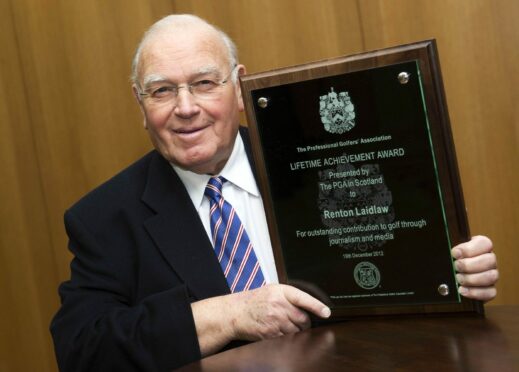The R&A and USGA seemed to make their first move in properly controlling the distance the golf ball is travelling last week.
But it’s not even a baby step. It’s not really a toe dipped in the water. It’s barely a toenail clipping.
Indeed, few would have probably cared or remembered had Phil Mickelson not launched a basically one-man campaign at the very last minute to try to stop it. Only, some of us saddoes both care and remember, so Phil ended up looking rather stupid.
This was flagged up six months ago
Starting Jan. 1, 2022, a new Model Local Rule will be available to provide competition organizers with the option of limiting the maximum club length (excluding putters) to 46”, with a focus on elite amateur and professional events.
Tap ⬇️ for more details.
— USGA (@USGA) October 12, 2021
The R&A actually announced this back in February. When they started the final consultations on their Distance Insight project findings – at last – that said they were probably going allow a local rule to allow tournament organisers limit the length of clubs (effectively just drivers) to 46 inches.
The R&A and USGA also stressed this was not a solution to distance. It was merely a complimentary measure they could implement reasonably quickly. They first had the idea, they added, in 2014, which shows you what passes for “quickly” among golf’s governing bodies.
The main course of measures has yet to come, with the manufacturers’ deadline for Distance Insights responses only at the start of next month. Those will need to be examined and debated, no doubt. We’re still miles away from any really effective measures.
So why do this now? There’s not a queue of players looking to use clubs over 46 inches. It’s a weed in the corner of the yard that’s barely sprouted but been drenched with Pathclear.
Bryson DeChambeau, who appears and claims to be on the cutting edge of these things, told us back in February that he’d tried and rejected a 48-inch driver. A handful of players – 3% of pros, the governing bodies believe – were using anything longer than 46 inches.
Phil’s curious tirade
Phil Mickelson’s latest swipe at USGA more about grandstanding than the future of golf https://t.co/qx7WBuCGkV via @golfweek
— Eamon Lynch (@eamonlynch) October 16, 2021
One was Mickelson, who used a 47.9-inch driver when he won the PGA in May. Mickelson’s outspoken reaction to the measure on Twitter – “PATHETIC, SAD, STUPID” was at least curious. Not least because it sounded exactly like a certain ex-President of the USA when he used that vehicle.
But Phil’s outrage was utterly disingenuous. He’d had six months to make his representations like everyone else. If there had been a proper groundswell of opposition from manufacturers, players and the Tours, the proposal wouldn’t have got past the foothills.
Instead, it’s sailed through almost unopposed. The PGA Tour’s Players’ Advisory Council – the body which represents the rank and file of tour pros – nodded it through. Finger on the pulse, eh, Phil?
One of the foundations of Phil’s argument was that the amateur governing bodies were taking the “fun” out of the game for the recreational golfer. However this falls on the measure being implemented as a local rule at the discretion of the tournament organisers.
In effect, it’s bifurcation
And here’s where the move had some relevance. It’s a tiny shuffle towards distance control. But it’s a bigger step towards the process where that might be achieved, bifurcation of the game in elite and recreational levels.
Distance only needs to be controlled at the top level – the professional tours and elite amateurs. The rest of us can and should be allowed to whale away with what we like.
Mike Whan, the relatively new chief executive of the USGA, has broken the previously unassailable ranks defending the myth that golf is played with the same equipment from junior beginners all the way to Jon Rahm.
It’s ludicrous anyway – the kit that Rahm and Rory and Tiger and Phil use has long been utterly different than Jim W Hacker’s. But Whan has voiced the rather obvious question “why is that we’re so afraid of bifurcation?”
What will be lost by dropping this pointless myth? The game is quite robust enough to survive an admission that it’s actually a lie.
And it certainly won’t result in the obsolescence of the Old Course and golf’s other precious historic treasures. Or diminish golf’s variety of strategy and skills. Nor will it cause the game to eat up unsustainable amounts of natural resources to feed ever larger properties.
Not doing anything risks all these. The new local rule is bifurcation, in effect. It seems to be the choice the governing bodies want to make going forward.
And quite rightly. Do we want to see Phil Mickelson get 15 or more extra yards, or do we want the Old Course to be the prime Open Championship venue for another century and a half?
There’s no choice to be made here, surely.
The old boys of summer
Times do change, inevitably. The loss of the much-loved Renton Laidlaw last week was a reminder of that, if you’ll forgive me for getting personal.
Renton was simultaneously one of a kind but also a member of a great old school that were in situe when I started this beat in the late 1980s, early 1990s.
Then there were 8 to 12 journalists that covered the Scottish Amateur Championship every August for daily and evening papers, radio and even TV.
There was Renton, and the Express’ Jock MacVicar, who we also lost this year. Iain McNiven of the Evening News, Jackie Robertson of the Evening Times.
Peter Donald of the Telegraph (and sometimes the Daily Mail), Raymond Jacobs from the (then Glasgow) Herald, Ian Wood or sometimes Norman Mair of the Scotsman. Alister Nicol of the Record, and Scott Crockett (now the European Tour’s director of communications) freelancing anyone not there.
All of them but Scott and I had been doing the beat for 20 years or more. My immediate impression was – this job must be a really good one if these guys have all been doing it so long.
It was, and still is. Even if really no-one covers the Scottish Amateur on site anymore. And but for Scott and I, all my great old friends are now gone.


